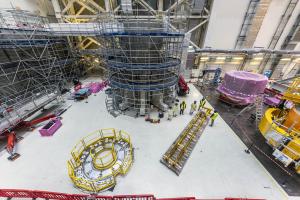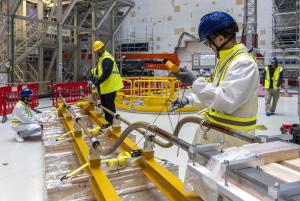More than just "stacking"
Sitting at the very centre of the vacuum vessel, the central solenoid is a 1,000-tonne magnet made of six cylindrical modules stacked one on top of another. "Stacking," however, doesn't reflect the range, complexity and precision of the operations involved in assembling the giant component—the tallest and heaviest inside the ITER machine.
The six modules required for the central solenoid (plus an additional spare) are procured by the United States and manufactured by General Atomics in California. Of the four that have been delivered to ITER, two are fully installed and preparation work is underway to add a third to the already 6-metre-tall assembly standing on its bespoke platform.
Installing a 120-tonne superconducting module requires both heavy machinery and subtle adjustment devices. As the approximately 2.4-metre-tall components are positioned, any deviation from nominal would be progressively amplified as the assembly progresses. And the tolerance for deviation is low: no more than 20 mm for the entire 18-metre-tall structure once completed. In this quest for near-absolute precision nothing is trivial: the formulation of the concrete that anchors the platform plays a part, as does the way bolts are tightened.
However, for a time the module is slightly offset from the assembly axis to enable a series of delicate operations that need to be performed: creating the joints for the electrical lead extensions, welding the joint cases, and testing the high-voltage insulation of the superconducting joints before lifting and moving the module a few dozen centimetres into its final position.
Last week, experts from the Magnet Project were busy with the electrical site acceptance test (grounding continuity, low voltage insulation resistance, high voltage insulation resistance) prior to preparing the installation of one of the helium-cooled busbar lead extensions that feeds 40 kA electric current to the magnet. In the coming weeks, the third module (wrapped in pink protective plastic to the right of the image) will undergo the same installation procedures.



